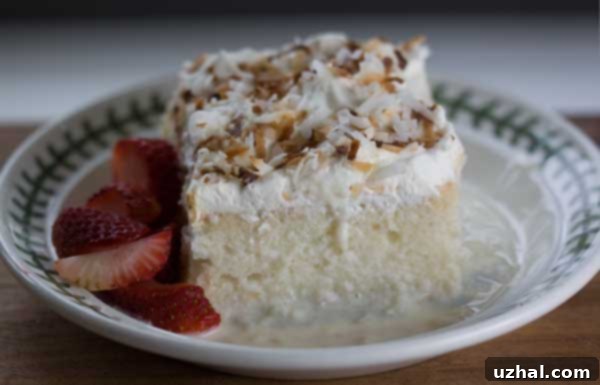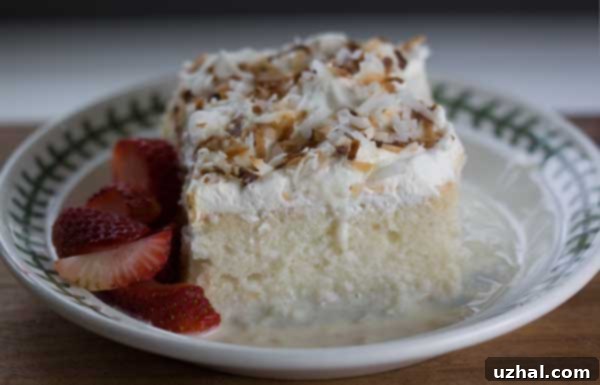Mastering Tres Leches: A Culinary Journey to Find the Perfect Three-Milk Cake Recipe
The quest for the ultimate Tres Leches Cake is officially underway! Just yesterday, I proudly shared a photo and a brief review of a Tres Leches Cake I baked, based on a recipe from Chowhound.com. While the cake was undoubtedly delicious and thoroughly enjoyed by Todd, my discerning taste tester, it also sparked a new culinary obsession. My initial attempt, though good, left me pondering the finer points of this beloved dessert. The crumb, for instance, wasn’t as tight as I’d hoped, and the cake seemed to possess a richness that hinted at a higher-than-usual egg count. These observations have ignited a “Tres Leches madness” in my kitchen, prompting me to dive deep into the world of three-milk cakes to test a myriad of new recipes and uncover the secrets to perfection.

Understanding the Essence of Tres Leches Cake
Before embarking on this extensive baking adventure, it’s crucial to understand the fundamental components that make a Tres Leches Cake so uniquely delightful. At its heart, Tres Leches, meaning “three milks,” is a sponge cake soaked in, as its name suggests, three types of milk. This soaking process transforms a simple cake into an incredibly moist, rich, and tender dessert that’s a staple in many Latin American cultures.
The Sponge Cake Base: A Foundation of Airiness and Absorption
Most traditional Tres Leches cakes begin with a very basic sponge cake base. This typically involves a delicate balance of whipped egg whites, egg yolks, sugar, and flour. The magic lies in the aeration achieved by whipping the egg whites into stiff peaks, which lends the cake its characteristic light and airy texture. This airiness is not just for enjoyment; it’s vital for allowing the cake to absorb copious amounts of the milk mixture without becoming dense or soggy.
However, the world of Tres Leches sponge cakes is far from monolithic. There are numerous variations in the base recipe that can significantly impact the final texture and flavor:
- Added Liquids: Some recipes incorporate milk, vanilla extract, or oil directly into the batter. Oil, for example, can contribute to a softer, more tender crumb, which could be an interesting counterpoint to my previous cake’s slightly loose texture.
- Convenience Enhancements: Believe it or not, some popular recipes achieve excellent results with the addition of a little cake mix. This can simplify the baking process while still delivering a satisfying structure capable of soaking up the milks.
- Nutty Notes: For a different flavor profile and texture, some recipes call for ground almonds in the cake batter, adding a subtle richness and unique crumb.
- Cake Flour vs. All-Purpose: The type of flour can also play a role. Cake flour, with its lower protein content, typically yields a more tender and delicate crumb compared to all-purpose flour, potentially contributing to a perfectly soft foundation for soaking.
The “Tres Leches” Mixture: The Heart of the Cake’s Indulgence
The true soul of a Tres Leches Cake lies in its signature soaking liquid. Typically, this decadent mixture consists of three key dairy components:
- Evaporated Milk: This unsweetened, concentrated milk provides a deep, slightly caramelized flavor and contributes to the overall richness.
- Sweetened Condensed Milk: Thick and intensely sweet, condensed milk is crucial for adding the characteristic sweetness and velvety texture to the soaking liquid.
- Heavy Cream: The cream adds a luscious richness and helps to balance the sweetness, contributing to a wonderfully moist and luxurious mouthfeel.
While this trinity forms the traditional base, the “leches” mixture also offers exciting opportunities for experimentation. My recent Chowhound cake, for instance, boldly replaced heavy cream with coconut milk, imparting a delightful tropical twist. I’ve also had a memorable experience years ago with a version that incorporated sour cream into the mixture, which resulted in a wonderfully tangy and rich cake that I still recall fondly. Other creative variations might include a splash of rum or brandy for a more adult dessert, or a hint of cinnamon or vanilla to enhance the aromatic profile.
My Tres Leches Journey Begins: Lessons from the First Attempt
My first foray into Tres Leches with the Chowhound.com recipe was a valuable learning experience. While the flavor was undoubtedly pleasing, the texture provided key insights into what I’m seeking in my ideal Tres Leches. The “loose crumb” I observed suggests that the cake might have been a bit too tender or perhaps slightly under-structured to hold the milk mixture as perfectly as I envision. A tighter crumb typically indicates a cake that can absorb the liquid more evenly and maintain its structural integrity, preventing it from feeling overly mushy.
Furthermore, the perceived “more eggs than usual” could contribute to a denser, richer cake, which might be desirable for some, but I’m looking for that quintessential airy sponge that effortlessly soaks up the milks. This initial experience has only fueled my determination to explore how different ratios of ingredients and variations in technique can lead to that elusive “perfect” Tres Leches.
Exploring Promising Tres Leches Recipes: A Deep Dive into Variations
My research has already yielded a treasure trove of promising Tres Leches recipes, each offering a unique approach to this beloved dessert. Here’s a closer look at some of the contenders that have caught my eye:
-
Tres Leches Cake with Cake Flour and Oil: This recipe immediately piqued my interest. The use of cake flour, known for producing a lighter and more tender crumb, combined with oil in the base, suggests a cake that might be exceptionally soft and moist. The oil could contribute a silkiness that butter often doesn’t, potentially solving my “loose crumb” issue by making the cake inherently more tender and absorbent without being fragile.
-
Emeril Lagasse’s 5-Star Tres Leches Cake: When a recipe boasts a five-star rating from a culinary icon like Emeril, it’s definitely worth investigating. This recipe notably includes milk directly in the batter, which could contribute to a softer and richer cake even before the soaking process. The addition of meringue on top is a classic and visually stunning finish, offering a delightful contrast in texture to the moist cake below.
-
SF Gate Cake with Berry Sauce: This SF Gate recipe presents an intriguing proposition. While it appears to use a significant number of eggs, the article notes that it’s still proportionately fewer than the coconut Tres Leches I made yesterday. This suggests a potentially lighter, yet still flavorful, sponge. What truly captivated me about this recipe, however, is the innovative idea of a berry sauce. The tartness of berries would offer a beautiful counterpoint to the sweetness of the milks, adding a fresh, vibrant dimension to the cake.
-
Food and Wine Tres Leches with Dulce de Leche: This recipe features a base cake similar to the Chowhound version I just tried, but with a crucial difference in technique. It instructs you to cut the cake into pieces and then set it in the pan with the soaking mixture. This unique method could ensure more thorough and even saturation of the cake, potentially leading to an even moister result. The addition of dulce de leche, a rich caramel-like sauce, promises an extra layer of indulgent sweetness and depth of flavor.
-
Betty’s Tres Leches (Cake Mix Enhanced): Sometimes, convenience is king, especially when balancing flavor and effort. The fact that 199 people don’t mind the cake mix enhancement in “Betty’s Tres Leches” speaks volumes about its effectiveness. A good quality cake mix can provide a consistent and tender base, making it a viable option for those times when a scratch cake feels too daunting, yet still wanting a delicious Tres Leches.
-
Cuisinart Stand Mixer Contest Winning Coconut Tres Leches: This award-winning recipe, also utilizing a touch of cake mix, specifically highlights a coconut variation. Given my recent experience with a coconut-infused Tres Leches, I’m particularly interested in seeing how this recipe balances the coconut flavor with the traditional milks. A contest-winning recipe often indicates a well-tested and highly satisfying outcome.
-
Highly Praised Basic Cake from Allrecipes: Sometimes, the most basic recipes are the best, especially when they come with a high volume of positive reviews. This Allrecipes entry promises a straightforward yet highly praised Tres Leches. It’s a fundamental recipe that could serve as an excellent benchmark for understanding the core elements before diving into more complex variations.
-
Houston Chronicle Tres Leches Cake (Sour Cream & Meringue): This older recipe holds a special place in my memory. I made a variation of this one years ago, and I distinctly recall it being absolutely excellent. The inclusion of sour cream in the milk mixture lends a delightful tang and richness that cuts through the sweetness, while the meringue topping adds a beautiful, light texture. This is definitely one I need to revisit and recreate soon.
-
My First Ever Tres Leches Recipe (Cake Mix): This recipe holds sentimental value as it was the very first Tres Leches I ever attempted. I remember loving it back then, and I certainly didn’t mind the cake mix one bit. It proves that a truly delicious Tres Leches doesn’t always require a completely from-scratch approach and sometimes the simplest path yields wonderful results. Re-making this one could be a nostalgic and insightful comparison point for my current explorations.
Tips for Achieving Tres Leches Perfection
As I embark on this exciting journey, I’m gathering some essential tips to guide my baking and ensure each Tres Leches cake is a step closer to perfection:
- Don’t Overmix the Batter: For the sponge cake, once the dry ingredients are added, mix just until combined to prevent gluten development, which can lead to a tough cake.
- Whip Egg Whites Correctly: Achieving stiff but not dry peaks is crucial for the cake’s lift and airy texture.
- Prick the Cake Generously: Once baked and cooled slightly, use a fork or skewer to poke numerous holes across the surface of the cake. This allows the milk mixture to fully penetrate every part of the cake.
- Chill the Milk Mixture: Many recipes suggest using a cold milk mixture for soaking. This helps the cake absorb the liquid more slowly and evenly, preventing it from breaking down.
- Soak Overnight (If Possible): While some recipes allow for shorter soaking times, an overnight soak in the refrigerator often yields the most incredibly moist and flavorful results, allowing the cake to fully absorb and meld with the milks.
- Choose Your Topping Wisely: Traditional toppings include whipped cream or meringue. Fresh fruit, a sprinkle of cinnamon, or a drizzle of dulce de leche can elevate the presentation and flavor profile.
- Use the Right Pan: A sturdy baking dish that can contain the liquid is essential. A 9×13 inch pan is common, but ensure the sides are high enough.
The Tres Leches Madness Continues!
This “Tres Leches madness” is more than just a baking spree; it’s a dedicated exploration into the nuances of a beloved classic. Each recipe represents a different philosophy, a unique blend of ingredients and techniques that promise to reveal new facets of this wonderfully moist dessert. I’m excited to compare textures, analyze flavor profiles, and ultimately, discover what truly makes a Tres Leches cake sing.
Stay tuned for updates on this delicious journey. I plan to share my findings, triumphs, and perhaps even a few learning curves along the way. If you have a favorite Tres Leches recipe or any tips to share, I’d love to hear about them – because when it comes to Tres Leches, there’s always more to learn, and more to taste!
